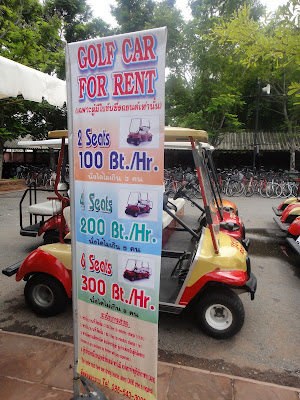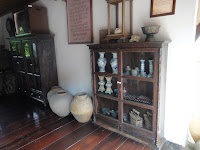此次旅程逐漸步入尾聲,今天的行程要外出小遠行,準備要去Ancient Siam。
先來個前情提要,先介紹一下Ancient Siam,這是泰國戶外大型的博物館,佔地 200 英畝,與泰國國土的形狀幾乎相同,可以說是全世界最大的戶外博物館,共有116個包含泰國76個府內最著名的古蹟、建築、紀念碑、廟宇的複製模型,展示著泰國將近800年來的歷史、文化、信仰、藝術與人民的生活習俗。
我今天仍然一早就得起床,因為這邊下午五點就閉館了,而這邊可以參觀的地方實在很多,所以九點多就準備出門,因為陳羅格對這裡興趣缺缺,所以我就一個人踏上旅途囉。
為了不浪費時間,所以我大手筆的從BTS On Nut花了快300元坐計程車到達,泰國計程車是35元起跳,一次跳2元,由此可以知道這裡是有多麼遠了。在前往Ancient Siam的旅途中,會先經過三頭象博物館,據說裡面也有得逛,不過這不是我此行的目標,所以就請司機稍微停下車,我照張相就好。
三頭象博物館
我們終於抵達Ancient Siam了,以下就是裡面的介紹。
Ancient Siam的入口,此門牌約有4-5層樓高
購票處
園區內提供遊園車(類似高爾夫球車),不過所費不貲
兩人座位一小時就是要100B,整個園區認真逛下來4.5個小時跑不掉阿~
不過園區提供免費的腳踏車,我當然選擇這種服務,又可以順便當個追風少年
這張是那邊服務人員主動幫我照的,是不是青春洋溢阿~
接著我們就準備出發啦,如同前文所述,這個園區幾乎比照泰國國土的形狀來做規劃,大致上分為泰國南部、中部、北部、東北部及東部。入口處就在最南方的位置。
不過園區實在太大,加上我還不夠在地,所以還是miss了幾個景點,不過我大致上還是拍了近百個點。以下就來看圖說故事。(以下的英文說明摘自於官網)
2. The Thai Pavilion
Traditionally, a Thai pavilion (or sala) is built outside the city walls in front of the main gate, to serve as a shelter for travellers who are waiting to enter the city while the city gate is still closed, because the city entrance is opened only at certain times.
Thai pavilion at Muang Boran is built in the Sukhothai style. The roof is pitched at an extremely acute angle and is supported by round wooden pillars and beams, unique style of Sukhothai art.
6. The Thai Pavilion
Manohra is one of the main characters of Suthon Jataka-the story appears in a collection of stories called Panasa Jataka. The religious tale of Manohra became a popular local fiction in Southern Thailand.
7. The Stupa of Phra Maha That, Nakhon Si Thammarat
The monastery is a remarkable architectural reminder of the artistic virtuosity of the southern Thai ar chi tects. The stupa, where the Buddha relics are housed, was built during the reign of King Si Thammasokarat in 555 A.D. when Nakhon Si Thammarat was first established. The structure is obviously influenced by the Sin gha lese art.
The stupa at Muang Boran is smaller than the original one at Nakhon Si Thammarat by one-third.
The stupa at Muang Boran is smaller than the original one at Nakhon Si Thammarat by one-third.
8. The Pallava Group of Images, Phang-nga
The images of the three Hindu deities, Vishnu, Shiva and Laksamee were carved out of stone by Pallava sculptors living in southern India around the 8th-9th centuries A.D. Later during the fifth reign in Rattanakosin period King Rama VI, who was still the Crown Prince, travelled to see
these images whose faces and bodies strangely stood out of the trunk of a tree that had grown around them. Nobody knows where the images come from. However, from the ornaments and hair styles, we can pre sume that the statues are of Indian origin.
Now these images are kept at the Nakhon Si Thammarat National Museum.
9. The Stupa of Phra Maha That, Chaiya, Surat Thani
The Phra Maha That is one of the most sacred and important monasteries in the south of Thailand. The structure of this stupa is similar to the Chandi Pawana Chedi in Indonesia, the mondop style chedi, which was modeled after Chandimendut Chedi of Java.
The Phra Maha That is one of the most sacred and important monasteries in the south of Thailand. The structure of this stupa is similar to the Chandi Pawana Chedi in Indonesia, the mondop style chedi, which was modeled after Chandimendut Chedi of Java.
The square stupa of Phra Maha That Chaiya standing on a rectangular base is built solely of brick. The structure is ornamented with delicate stucco designs. In the four corners of the raised platform are diminutive round brick Ceylonese chedi of which the spires are decorated with a four-faced stucco Bodhisattva Avalokitesvara in accordance with Mahayana Buddhism.
The main tower standing in the center is a round chedi serving as the upper story of a relic cham ber or an image house.
10. The Old Market Town
The Old Market Town or Talad Bok has been recreated to portray the atmosphere of an ancient Thai community. The self-con tained community of an old market town makes it possible for the towns people to live on their own; the town pro vides sufficient facilities and necessary structures which are important for the physical and psychological well-being of the people. There are shops selling all kinds of goods, entertainment centers such as theaters and casinos, and religious monuments like the spirit houses standing side by side in the community. The structures play an important role in the towns because they help cultivate a good understanding among the multiethnic groups of people. So, the people live peacefully and spend their lives in the way that they are used to.
The residential quarters in the old market town are inspired by those standing along the ancient road in Tak Province together with the local shops in Kamphaeng Phet. The traditional Thai houses are taken from an old community in Yan Nawa District, Bangkok. On visiting the site, travellers will be reminded of the spectacle of an ancient market town that was once vital in Thai communities.
11. The Tiger Kings Palace, Phetchaburi
12. The Scripture Repository
13. The Bell Tower
In the past, the scripture repository is normally raised on piles over a pond to protect the palm leaf manu scripts from ants and termites. The building of this type can hardly be found any where in Thailand today. The one at Muang Boran has been built and preserved for posterity.
The repository was brought from Wat Yai, Bang Khonthi in Samut Songkhram Province. Its original build ing, standing in a pond at Wat Yai, was much dilapidated. The structure is likely modeled after the Ayutthaya architectural style. The walls on the outside are invaluable old murals of the Life of the Buddha which are painted with tempera sketches gilded with gold. The murals are faded now.
Nearby is located a bell tower which has a unique local style and is hardly seen today. Muang Boran obtained this building from the same monastery.
14. The Stupa of Phra Maha That, Ratchaburi
The Stupa of Phra Maha That, Ratchaburi Province represents Mahayana Buddhism and was con struct ed during the Lop Buri period which dates to around the 11th-13th century A.D. The brick central tower stands on a laterite base. The structure has been renovated and restored several times. The murals in the chamber of the prang were made during the early Ayutthaya period while the stuccos and ornaments on the upper part of the prang were executed by both Ayutthaya and Rattanakosin craftsmen.
Phra Maha That, Ratchaburi situated at Muang Boran is a three-fourths scaled model of the original struc ture.




























































